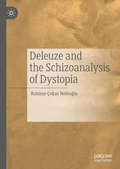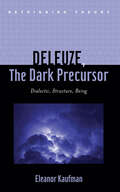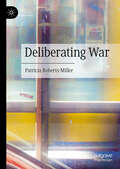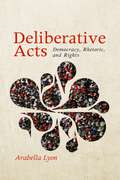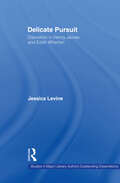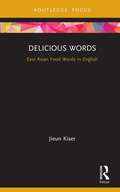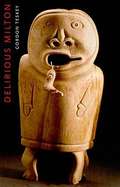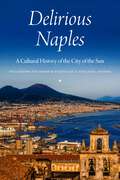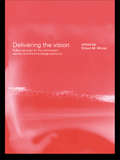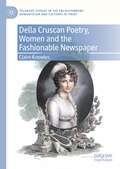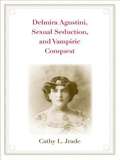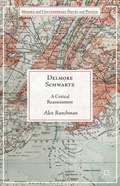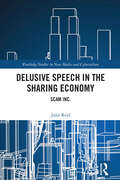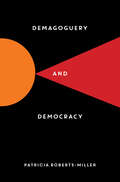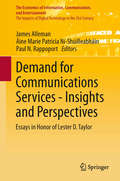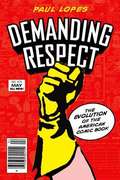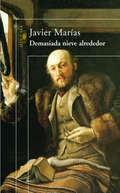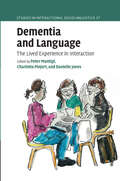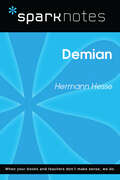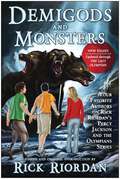- Table View
- List View
Deleuze and the Schizoanalysis of Dystopia
by Rahime Çokay NebioğluThis book offers an insightful history of dystopian literature, integrating it within the conceptual schemas of Deleuze and Guattari. Unlike earlier examples of dystopia which depict representations of a possible future that is remarkably worse than present society, contemporary dystopia often tends to portray an almost allegorical re-presentation of present society. Tracing dystopia’s shift from transcendence towards immanence with the rise of late neoliberal capitalism and control-societies, Çokay Nebioğlu skilfully constructs a new taxonomy of dystopian fiction to address this changing dynamic. Accompanied by a subtle exploration of earlier and later examples of the genre by George Orwell, Aldous Huxley, Suzanne Collins, Veronica Roth, William Gibson, Max Barry, Dave Eggers, Cindy Pon, and Tahsin Yücel along with rich and nuanced analysis of China Mieville’s Perdido Street Station and Margaret Atwood’s MaddAddam trilogy, the book seeks not only to track the transformation of dystopia in light of worldwide cultural, political and economic transformation, but also to conduct a schizoanalytic reading of dystopia, thus opening up an exciting field of enquiry for Deleuzian scholars.
Deleuze, The Dark Precursor: Dialectic, Structure, Being (Rethinking Theory)
by Eleanor KaufmanA thoughtful and original analysis of the writings of influential French philosopher Gilles Deleuze.Gilles Deleuze is considered one of the most important French philosophers of the twentieth century. Eleanor Kaufman situates Deleuze in relation to others of his generation, such as Jean-Paul Sartre, Pierre Klossowski, Maurice Blanchot, and Claude Lévi-Strauss, and she engages the provocative readings of Deleuze by Alain Badiou and Slavoj Žižek.Deleuze, The Dark Precursor is organized around three themes that critically overlap: dialectic, structure, and being. Kaufman argues that Deleuze's work is deeply concerned with these concepts, even when he advocates for the seemingly opposite notions of univocity, nonsense, and becoming. By drawing on scholastic thought and reading somewhat against the grain, Kaufman suggests that these often-maligned themes allow for a nuanced, even positive reflection on apparently negative states of being, such as extreme inertia. This attention to the negative or minor category has implications that extend beyond philosophy and into feminist theory, film, American studies, anthropology, and architecture.
Deliberating War
by Patricia Roberts-MillerThis book argues that treating politics as war derails essential democratic processes, including deliberation and policy argumentation, in complicated ways. “Politics is war” is not always just a figure of speech, but often a sincere expression of how people see disagreement—they mean it literally—and they use it to evade the responsibilities of rhetoric. This book takes the metaphor seriously. Using a series of case studies ranging from the 432 BCE “Debate at Sparta” to Bill O’Reilly’s recent invention of a “War on Christmas,” Deliberating War illustrates pathologies of deliberation that arise when a community understands itself to be at political war. This book identifies recurrent rhetorical strategies that constrain or even effectively prohibit deliberation, such as deflecting, reframing, threat inflation, appealing to paired terms, claiming moral license, radicalizing a base. In short, what seems to be an effective solution to an immediate rhetorical problem—using hyperbole and demagoguery to persuade people to adopt a specific leader or policy—is a trap that prevents democratic practices of compromise, deliberation, fairness, reciprocity. Unhappily, threat inflation—even when well-intentioned--At some point, hyperbolic rhetoric becomes threat inflation, and then that inflated threat becomes the premise of policies, both foreign and domestic. And then agreeing as to the obvious existential threat posed by the Other and uniting behind the obvious policy solution is a necessary sign of being on the side of Good. Once communities become persuaded that they are in an apocalyptic battle between Good and Evil, politics as war can quickly become real war—often with far-reaching and catastrophic consequences.
Deliberative Acts: Democracy, Rhetoric, and Rights (Rhetoric and Democratic Deliberation #7)
by Arabella LyonThe twenty-first century is characterized by the global circulation of cultures, norms, representations, discourses, and human rights claims; the arising conflicts require innovative understandings of decision making. Deliberative Acts develops a new, cogent theory of performative deliberation. Rather than conceiving deliberation within the familiar frameworks of persuasion, identification, or procedural democracy, it privileges speech acts and bodily enactments that constitute deliberation itself, reorienting deliberative theory toward the initiating moment of recognition, a moment in which interlocutors are positioned in relationship to each other and so may begin to construct a new lifeworld. By approaching human rights not as norms or laws, but as deliberative acts, Lyon conceives rights as relationships among people and as ongoing political and historical projects developing communal norms through global and cross-cultural interactions.
Deliberative Acts: Democracy, Rhetoric, and Rights (Rhetoric and Democratic Deliberation)
by Arabella LyonThe twenty-first century is characterized by the global circulation of cultures, norms, representations, discourses, and human rights claims; the arising conflicts require innovative understandings of decision making. Deliberative Acts develops a new, cogent theory of performative deliberation. Rather than conceiving deliberation within the familiar frameworks of persuasion, identification, or procedural democracy, it privileges speech acts and bodily enactments that constitute deliberation itself, reorienting deliberative theory toward the initiating moment of recognition, a moment in which interlocutors are positioned in relationship to each other and so may begin to construct a new lifeworld. By approaching human rights not as norms or laws, but as deliberative acts, Lyon conceives rights as relationships among people and as ongoing political and historical projects developing communal norms through global and cross-cultural interactions.
Delicate Pursuit: Discretion in Henry James and Edith Wharton (Studies in Major Literary Authors #13)
by Jessica LevineFirst published in 2002. Routledge is an imprint of Taylor & Francis, an informa company.
Delicious Words: East Asian Food Words in English
by Jieun KiaerAs societies across the globe are becoming increasingly interwoven at an unprecedented speed and across an impressive scope, so too is the world of food, allowing the English language to develop an ever-widening culinary vocabulary. This book examines the lives of such words in today’s discourse on eating and drinking, focusing on foreign - particularly East Asian - influences on culinary terms in English, and how words are born and evolve in a modern transcultural environment. Through the lens of culinary words, this book demonstrates that foreign-origin and hybrid words, previously considered marginal, have become a main source of new imports into our daily lexicon. With case studies from Japan to Mongolia, Hong Kong to Korea, China to Vietnam, and beyond, this book examines how more and more words are becoming borderless and forming their own new global identities. By showcasing some lesser-known regional cuisines, alongside staple dishes that many of us already know and love, this book offers a wide range of examples in order to illustrate the metamorphosis of the manner in which we engage with food words. This book will be of interest to general readers, as well as those who are engaged in East Asian studies, English linguistics, intercultural communication studies, translation studies, and lexicography.
Delights
by Shane Templeton J. David Cooper John J. Pikulski David J. Chard Gilbert Garcia Claude Goldenberg Phyllis Hunter Marjorie Y. Lipson Sheila Valencia Maryellen VogtNIMAC-sourced textbook
Delirious Milton: The Fate of the Poet in Modernity
by Gordon TeskeyComposed after the collapse of his political hopes, Milton's great poems Paradise Lost, Paradise Regained, and Samson Agonistes are an effort to understand what it means to be a poet on the threshold of a post-theological world. The argument of Delirious Milton, inspired in part by the architectural theorist Rem Koolhaas's Delirious New York, is that Milton's creative power is drawn from a rift at the center of his consciousness over the question of creation itself. This rift forces the poet to oscillate deliriously between two incompatible perspectives, at once affirming and denying the presence of spirit in what he creates. From one perspective the act of creation is centered in God and the purpose of art is to imitate and praise the Creator. From the other perspective the act of creation is centered in the human, in the built environment of the modern world. The oscillation itself, continually affirming and negating the presence of spirit, of a force beyond the human, is what Gordon Teskey means by delirium. He concludes that the modern artist, far from being characterized by what Benjamin (after Baudelaire) called "loss of the aura," is invested, as never before, with a shamanistic spiritual power that is mediated through art.
Delirious Naples: A Cultural History of the City of the Sun
by Pellegrino D’Acierno and Stanislao G. PuglieseThis book is addressed to “lovers of paradoxes” and we have done our utmost to assemble a stellar cast of Neapolitan and American scholars, intellectuals, and artists/writers who are strong and open-minded enough to wrestle with and illuminate the paradoxes through which Naples presents itself. Naples is a mysterious metropolis. Difficult to understand, it is an enigma to outsiders, and also to the Neapolitans themselves. Its very impenetrableness is what makes it so deliriously and irresistibly attractive. The essays attempt to give some hints to the answer of the enigma, without parsing it into neat scholastic formulas. In doing this, the book will be an important means of opening Naples to students, scholars and members of the community at large who are engaged in “identity-work.” A primary goal has been to establish a dialogue with leading Neapolitan intellectuals and artists, and, ultimately, ensure that the “deliriously Neapolitan” dance continues.
Delivering the Vision: Public Services for the Information Society and the Knowledge Economy
by Eileen M. MilnerPolitical rhetoric surrounding the role of information and knowledge in society in the twenty-first century is often thrown into sharp relief by the realities of practice. Delivering the Vision explores the way in which public service visions have developed globally and how successful they have been in contributing to major social and economic change.This edited text contains a range of case studies from the United Kingdom, the Republic of Ireland, Canada, the USA and Australia. Contributors focus both on those factors critical to success and on reasons for failure, but a common theme to emerge across all contributions is the requirement for a clear political vision, commitment and leadership if the shift from traditional forms of social and economic organisation to high-value, knowledge-intensive economies is to be safely negotiated. At the same time, individual case studies provide valuable blueprints for successful implementation of an ambitious public service change agenda.Delivering the Vision is accessible and relevant to all those interested in the management and reform of public sector organisations. It is a companion volume to the editor's earlier text Managing Information and Knowledge in the Public Sector (Routlegde: 2000)
Della Cruscan Poetry, Women and the Fashionable Newspaper (Palgrave Studies in the Enlightenment, Romanticism and Cultures of Print)
by Claire KnowlesThis book explores Della Cruscan poetry in the late eighteenth-century literary scene. A sociable, ornate, and deeply theatrical type of poetry, Della Cruscanism was associated with writers like Robert Merry, Mary Robinson, and Hannah Cowley. While Merry is the poet most commonly associated with the Della Cruscan school, this book argues that Della Cruscanism was a movement dominated by female poets and that this was one of the key reasons for the later disavowal and downgrading of its poetic accomplishments. It offers a close examination of these women writers and their role in shaping the poetic culture of the fashionable newspaper. In doing so, this study offers the first account of the feminization of the fashionable newspaper and of popular literary culture in the final years of the eighteenth century.
Delmira Agustini, Sexual Seduction, and Vampiric Conquest
by Cathy L. JradeDelmira Agustini (1886–1914) has been acclaimed as one of the foremost modernistas and the first major woman poet of twentieth-century Spanish America. Critics and the reading public alike were immediately taken by the originality and power of her verse, especially her daring eroticism, her inventive appropriation of vampirism, and her morbid embrace of death and pain No work until now, however, has shown how her poetry reflects a search for an alternative, feminized discourse, a discourse that engages in an imaginative dialogue with Rubén Darío’s recourse to literary paternity and undertakes an audacious rewriting of social, sexual, and poetic conventions. In the first major exploration of Agustini’s life and work, Cathy L. Jrade examines her energizing appropriation and reinvention of modernista verse and the dynamics of her breakthrough poetics, a poetics that became a model for later women writers.
Delmore Schwartz
by Alex RunchmanTaking as its starting point Delmore Schwartz's self-appointment as both a 'poet of the Hudson River' and 'laureate of the Atlantic, ' this book comprehensively reassesses the poetic achievement of a critically neglected writer. Runchman reads Schwartz's poetry from In Dreams Begin Responsibilities to the posthumously-published Last & Lost Poems in relation to its national and international perspectives, recognizing tensions between the two but arguing that these more often animate his writing than hold it back. Addressing Schwartz's Jewish-American heritage, his attempts to negotiate the influence of T. S. Eliot, his use of allusion, his writing about the city, his responses to World War II, and his later poetry's euphonic symbolism, Delmore Schwartz: A Critical Reassessment reestablishes Schwartz's importance to his peers and successors. "
Delusive Speech in the Sharing Economy: Scam Inc. (Routledge Studies in New Media and Cyberculture)
by Julie ReidIn this examination of how the rise of online sharing economy platforms has facilitated online crime, this book shows how, while marketed as trustworthy peer-to-peer services, these platforms are highly vulnerable to misuse by scammers and are used for the dissemination of delusive speech.The analysis centres around the concept of delusive speech, a sub-set of disinformation, designed to deceive and motivate by criminal intent. Looking beyond the economic and disruptive impacts of sharing economy platforms like Uber, Airbnb, and others, this book situates these Big Tech giants as mass communication channels that are frequently misused by bad actors to distribute dangerous content globally. Drawing from over 600 cases of victims lured into scams or physical danger via misleading Airbnb listings, the book provides a detailed case study exposing Airbnb's failure to establish legitimate safety measures despite branding its platform as a 'community of trust'. Incorporating netnography and thematic analysis, the author theorises the deceptive semiotic structure of delusive speech and evaluates practical mechanisms Airbnb could employ to prevent scams and crime on its platform.With a global audience including researchers in communication and media studies, digital media, and media industries, as well as tech journalists, Silicon Valley critics, policymakers, and digital rights advocates, this book unmasks how sharing economy giants like Airbnb contribute to an epidemic of online deception causing real-world harm.
Demagoguery and Democracy
by Patricia Roberts-MillerA clear-eyed guide to demagoguery—and how we can defeat it What is demagoguery? Some demagogues are easy to spot: They rise to power through pandering, charisma, and prejudice. But, as professor Patricia Roberts-Miller explains, a demagogue is anyone who reduces all questions to us vs. them. Why is it dangerous? Demagoguery is democracy’s greatest threat. It erodes rational debate, so that intelligent policymaking grinds to a halt. The idea that we never fall for it—that all the blame lies with them—is equally dangerous. How can we stop it? Demagogues follow predictable patterns in what they say and do to gain power. The key to resisting demagoguery is to name it when you see it—and to know where it leads.
Demand for Communications Services - Insights and Perspectives
by James Alleman Áine Marie Patricia Ní-Shúilleabháin Paul N. RappoportThis volume grew out of a conference organized by James Alleman and Paul Rappoport, conducted on October 10, 2011 in Jackson Hole, Wyoming, in honor of the work of Lester D. Taylor, whose pioneering work in demand and market analysis has had profound implications on research across a wide spectrum of industries In his Prologue, Eli M. Noam notes that demand analysis in the information sector must recognize the "public good" characteristics of media products and networks, while taking into account the effects of interdependent user behavior; the strong cross-elasticities in a market; as well as the phenomenon of supply creating its own demand The second Prologue, by Timothy Tardiff and Daniel Levy, focuses more specifically on Taylor's body of work, in particular its practical applications and usefulness in analyses of, and practices within, the Information and Communications Technology (ICT) sector (known in Europe and elsewhere as the Telecommunications, Media, and Technology (TMT) sector) The remainder of the book is organized into four parts: Advances in Theory; Empirical Applications; Evidence-Based Policy Applications; and a final Conclusion The book closes with an Appendix by Sharon Levin and Stanford Levin detailing Taylor's contributions using bibliometrics. Not only featuring chapters from distinguished scholars in economics, applied sciences, and technology, this volume includes two contributions directly from Lester Taylor, providing unique insight into economics from a lifetime in the field. "What a worthy book! Every applied researcher in communications encounters Lester Taylor's work. Many empirical exercises in communications can trace their roots to Taylor's pioneering research and his thoughtful leadership. This book assembles an impressive set of contributors and contributions to honor Taylor. No surprise, the collection extends far and wide into many of the core topics of communications and media markets. The emphasis is where it should be-on important and novel research questions informed by useful data --Shane Greenstein, Professor of Management and Strategy, Kellogg School of Management, Northwestern University "For more than 40 years, Lester Taylor has been a leader in the application of consumer modeling, econometric techniques and microeconomic data to understand residential and business user behavior in telecommunications markets. During that time, he inspired a cadre of students and colleagues who applied this potent combination to address critical corporate and regulatory issues arising in the telecommunications sector. This volume collects the recent product of many of these same researchers and several other devotees who go beyond empirical analysis of fixed line service by extending Prof. Taylor's approach to the next wave of services and technologies. These contributions, including two new papers by Prof. Taylor, offer an opportunity for the next generation to learn from his work as it grapples with the pressing issues of consumer demand in the rapidly evolving digital economy. " -- Glenn Woroch, Adjunct Professor of Economics, University of California, Berkeley
Demanding Respect: The Evolution of the American Comic Book
by Paul LopesHow is it that comic books—the once reviled form of lowbrow popular culture—are now the rage for Hollywood blockbusters, the basis for bestselling video games, and the inspiration for literary graphic novels? In Demanding Respect, Paul Lopes immerses himself in the discourse and practices of this art and subculture to provide a social history of the American comic book over the last 75 years. Lopes analyzes the cultural production, reception, and consumption of American comic books throughout American history. He charts the rise of superheroes, the proliferation of serials, and the emergence of graphic novels. Demanding Respect explores how comic books born in the 1930s were perceived as a “menace” in the 1950s, only to later become collectors’ items and eventually “hip” fiction in the 1980s through today. Using a theoretical framework to examine the construction of comic book culture—the artists, publishers, readers and fans—Lopes explains how and why comic books have captured the public’s imagination and gained a fanatic cult following.
Demasiada nieve alrededor
by Javier MaríasEste volumen recoge noventa y seis artículos publicados entre febrero de 2005 y febrero de 2007, es decir, el tercer y el cuarto año de las colaboraciones de Javier Marías en El País Semanal. Dice el autor en su prólogo: «En España cada vez sirve de menos desmentir una información o desbaratar una creencia o echar por tierra una teoría; o explicar algo pacientemente, o rebatir opiniones, o demostrar lo ridículo o absurdo de una postura o de una costumbre o de una política. O razonar, en suma. Y así, la realidad española se repite infatigablemente, con una tendencia enfermiza a no escuchar ni enmendarse casi nunca, todavía menos a reconocer un error o una falacia y a disculparse por ellos. Esta actitud de fingir no haberse enterado es algo instalado en la sociedad, lo que antiguamente se llamaba "un vicio". El mensaje que yo suelo recibir es este: No me importa lo que usted ha dicho. Ni siquiera que me haya convencido con sus argumentos. Ni siquiera que yo vea que lleva razón. Yo voy a seguir en lo mío, como si usted no hubiera hablado. No se esfuerce, porque yo tengo un escudo infalible, lo que en nuestra lengua se llama "oídos sordos". Es muy fuerte, por tanto, la tentación de callarse, y antes o después sucumbiré a ella. A los lectores individuales que sí se dan por enterados, no sé si debo agradecerles o reprocharles que me lo hayan impedido hasta ahora». A nosotros no nos cabe duda: a autores como Javier Marías hay que agradecerles que, pese a todo, sigan hablando.
Dementia and Language: The Lived Experience in Interaction (Studies in Interactional Sociolinguistics)
by Peter Muntigl Charlotta Plejert Danielle JonesBringing together cutting-edge research from a group of international scholars, this innovative volume examines how people with dementia interact with others in a variety of social contexts, ranging from everyday conversation to clinical settings. Drawing on methods from conversation analysis, it sheds light on how people with dementia accomplish relevant goals in interaction, as well as how changes in an individual's discursive abilities may affect how conversationalists negotiate a world in common and continue to build their social relationships. By exploring interaction, this book breaks new ground in challenging the commonplace assumptions about what constitutes typical or atypical interactions in communication involving people with dementia, and further demonstrates the unique and creative strategies all speakers employ to facilitate better and more collaborative communication. It is essential reading for academic researchers and advanced students across sociolinguistics, interactional linguistics and conversational analysis, as well as health care practitioners.
Demian (SparkNotes Literature Guide Series)
by SparkNotesDemian (SparkNotes Literature Guide) by Hermann Hesse Making the reading experience fun! Created by Harvard students for students everywhere, SparkNotes is a new breed of study guide: smarter, better, faster.Geared to what today's students need to know, SparkNotes provides:chapter-by-chapter analysis explanations of key themes, motifs, and symbols a review quiz and essay topics Lively and accessible, these guides are perfect for late-night studying and writing papers.
Demigods and Monsters: Your Favorite Authors on Rick Riordan's Percy Jackson and the Olympians Series
by Rick Riordan and Leah WilsonWhich Greek god makes the best parent? Would you want to be one of Artemis' Hunters? Why do so many monsters go into retail? Spend a little more time in Percy Jackson's world—a place where the gods bike among us, monsters man snack bars, and each of us has the potential to become a hero. Find out: Why Dionysus might actually be the best director Camp Half-Blood could have How to recognize a monster when you see one Why even if we aren't facing manticores and minotaurs, reading myth can still help us deal with the scary things in our own lives Plus, consult our glossary of people, places, and things from Greek myth: how Medusa got her snake hair extensions, why Chiron isn't into partying and paintball like the rest of his centaur family, and the whole story on Percy's mythical namesake.
